Best Duplicate Content Checkers
It’s not good to make or have duplicate content on your website.
This is something that everyone will agree with, even if they don’t know anything about SEO. This is because having duplicate content on your website will hurt your brand’s image and could even be against the law, even if we don’t look at the SEO effects.
Webmasters today are quick to use DMCA to send a “takedown request” to any website that they find using their content without permission.
A lot of content validation is what SEO companies do to make sure their websites don’t have any copied content.
So why should you care about tools that check for duplicate content?
If you are the only one writing content for your website, you might not need a tool that checks for plagiarism or duplicate content.
But that doesn’t happen very often. A lot of business websites have in-house content writers who work as part of the marketing team. Some may hire freelancers to write their content.
The point is that a lot of the content on most business websites is written by people who aren’t in charge of keeping the site up to date. Some of these people may not even work for your company.
You need duplicate content checkers because you can’t trust everyone, especially when it comes to your company’s brand image, organic rankings, and traffic.
It is a good idea to run your website’s content through a duplicate content checker even if you are sure that none of the content is copied from somewhere else.
Now that you know why duplicate content checkers are important, here are five of our favorites (in no particular order):
1. Duplichecker
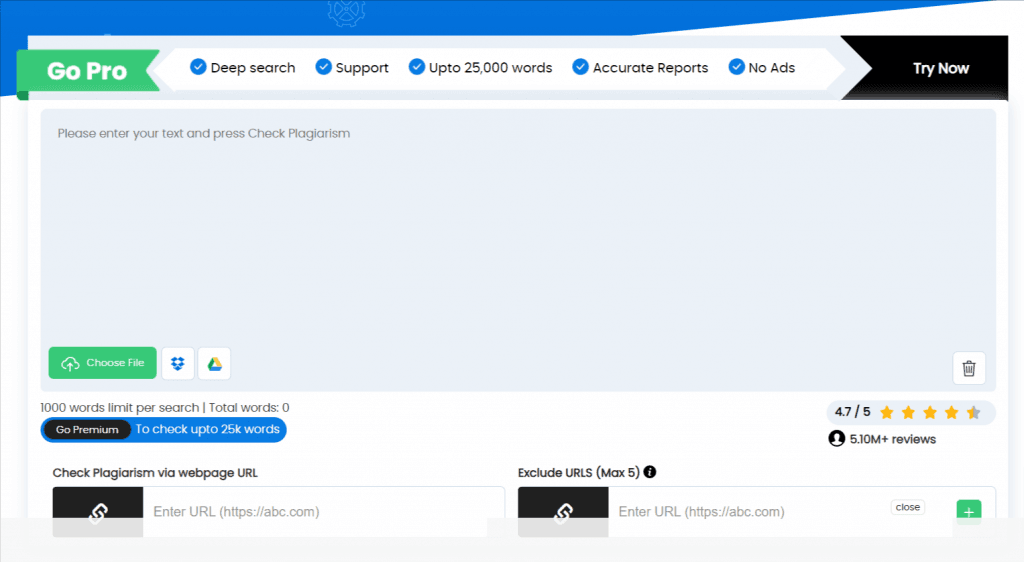
One of the best-known tools on the market, Duplichecker, comes with a lot of great features for free. The tool gives you accurate plagiarism reports 99% of the time, and you can enter the text in a number of ways, such as by pasting it into the tool’s website or uploading an MS Word file.
Because you can enter the URL of a real website into Duplichecker, you can even check it directly for copied content.
You can even get the plagiarism report as a PDF or MS Word file from the tool. You can get a better version of the Duplichecker for $30 a month. How much it costs will depend on how many words you want Duplichecker to check.
The premium version has something the Duplichecker team calls “Deep Scanning” and doesn’t have any ads. According to Duplichecker, this is what Deep Scanning means:
“This tool for checking for plagiarism will search through the millions of web pages that are available to find exact matches with your work.” According to the description, the deep scan feature will look through “the documents, websites, research papers, and articles to reveal the best results.”
In addition to its obvious ability to check for plagiarism, the Duplichecker website gives you access to a number of SEO/webmaster tools, such as a backlink checker, DA checker, paraphrasing tool, and the ability to search for images backwards.
The only thing that Duplichecker can’t do is scan more than a certain number of words at this time.
2. Siteliner
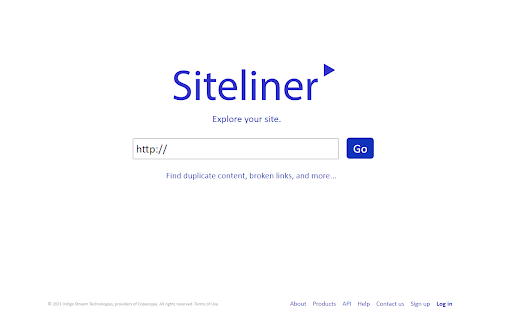
If you look at Siteliner next to Duplichecker, it might seem like a much easier tool. Siteliner, on the other hand, is better than Duplichecker in an awful lot of ways.
You can scan a whole website with Siteliner by just entering the site’s URL. In addition, Siteliner doesn’t let you check content that isn’t on a website, which could be seen as a weakness.
Siteliner can’t check an article for plagiarism if you get it in Google Docs and then want to put it on your website.
Siteliner is a powerful tool, though, so don’t let that fool you. Siteliner will look for broken links, number of words on each page, lists of internal and external links, and even the time it takes for each page on your website to load. It will also check your whole website for duplicate content. This whole list of information can even be downloaded as a PDF report from Siteliner.
Siteliner does let free users scan one website a month, though. For those who pay for Siteliner Premium, they can do as many scans as they want. If you are in charge of a lot of websites, you will probably find it very cheap.
3. Copyscape
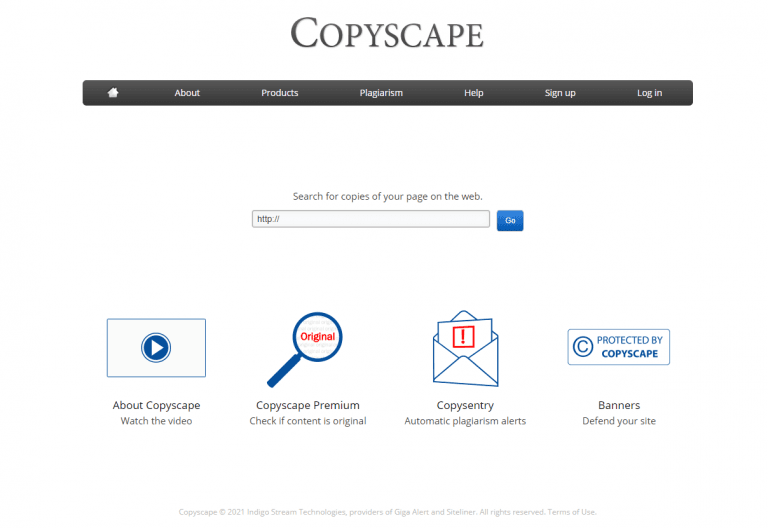
It’s easy to see why Copyscape is the most-used tool on this list. The simple plagiarism checker doesn’t have any cool extra features, but it does its job well.
Copyscape will check your whole website for free for copied content. For those who pay for a premium account, Copyscape will even break up the text on your website into smaller pieces to look for matches in which the text is partially copied. A “deep scan” like this is what Copyscape calls it.
Copyscape also has a service these days that they call Copysentry. Once you sign up for Copysentry, you almost never have to check your website for plagiarism by hand again. Without you having to do anything, Copyscape will regularly and automatically scan your website for copied content. If it finds any, it will let you know.
Even better, you can choose to use a Copyscape “banner” or trust badge to show people that the content on your website is totally original.
4. Small SEO Tools
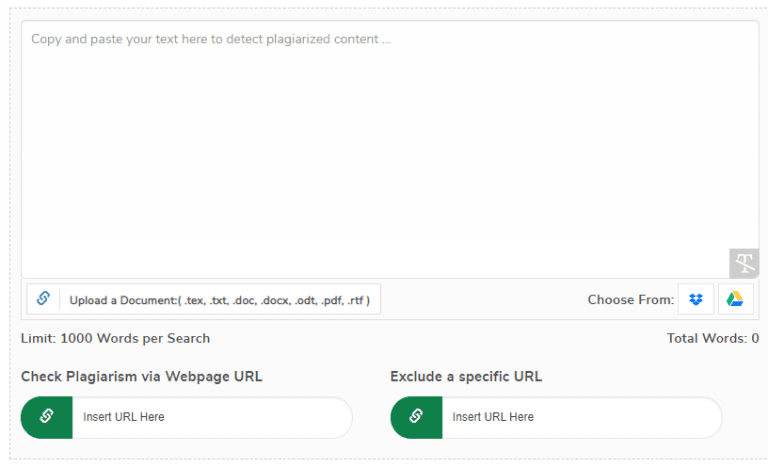
If you haven’t heard of Small SEO Tools yet, you should definitely check them out. Established in 2010, Small SEO Tools has grown to become one of the largest collections of free SEO and writing tools that anyone can use.
The Small SEO Tools plagiarizer looks through billions of pages to see if your work is copied from other sources. Still, it gets things done surprisingly quickly and correctly. The tool that checks for plagiarism can take both text (up to 1000 words per scan) and website URLs as input. Along with that, you can upload a text file or a file from Dropbox or Google Drive.
There’s also a cool feature that lets you scan whole websites without looking at certain pages.
You can also use the plagiarism checker tool as a browser plugin to quickly look for copied text on websites.
It’s important to remember that the plagiarism checker is part of a 17-tool suite for web text content. This is what it comes with:
5. Copyleaks
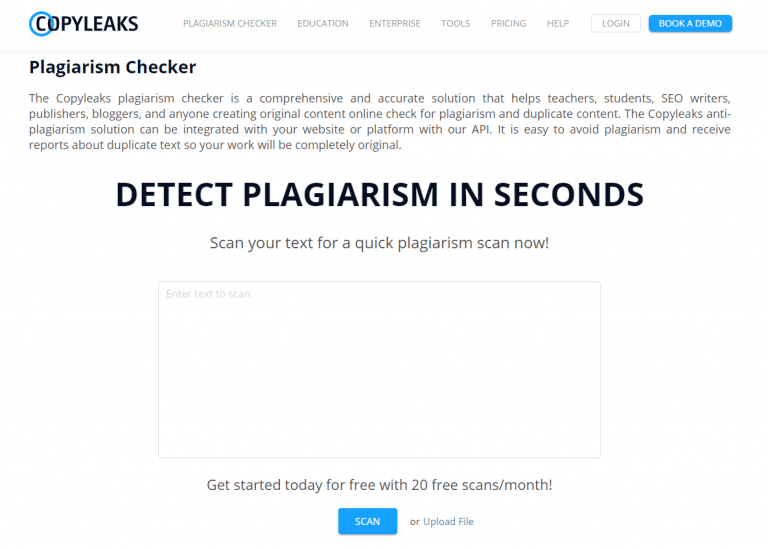
A cutting-edge plagiarism checker called Copyleaks uses AI to find out if your work has been copied from other sources.
Educational institutions often use Copyleaks because it can find content that has been “spun” or paraphrased.
Copyleaks’ website has a page called “Plagiarism Spectrum” that shows eight different kinds of plagiarism that Copyleaks can find. It can also check code assignments for plagiarism and can do this for more than 100 languages, including all the major Asian languages. Remember that Copyleaks works perfectly with both Google Docs and MS Word, so you can get real-time information about content that has been copied.
You can use Copyleaks for free as long as you don’t scan more than 20 files in a month. Also, the paid plans start at less than $10 a month, which makes Copyleaks one of the cheapest plagiarism checkers on the market right now.
Conclusion
Different plagiarism checkers have carved out their own little niches and offer features that are designed to meet the needs of those niches. You may have noticed this by now.
The best plagiarism checker for you will depend on what you do for a living and the type of content you want to check.
You should be able to start moving in the right direction after reading this.
If you need help with content copywriting, connect our expert team.





























 in India
in India